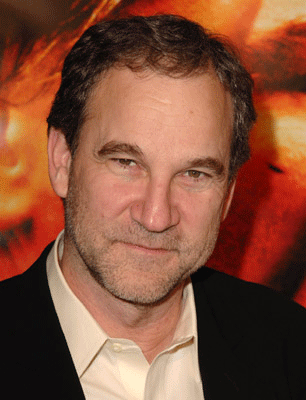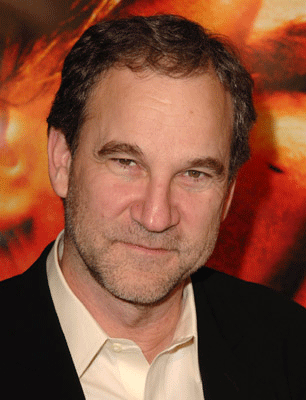Can a Hollywood Producer inspire Americans on Climate?
Air Date: Week of March 11, 2011
Producer Marshall Herskovitz (Photo: weblo.com)
A Hollywood producer is using his creative skills and contacts to try to convince the public that climate change is a problem. Marshall Herskovitz, whose credits include The Last Samurai, Legends of the Fall and Traffic, tells host Bruce Gellerman this his new campaign and media projects will urge Americans to dramatically reduce their energy use.
Transcript
GELLERMAN: Lights, camera, action”¦climate change? Hollywood recently rolled out the red carpet for a star-studded cast of UN officials. Secretary General Ban Ki Moon and the organization's climate chief Christiana Figueres took center stage. They urged film and TV industry bigwigs to pitch in and put their talents to use to raise awareness about global warming.
Among the 400 Hollywood celebs in the audience was Marshall Herskovitz - the producer of the TV series “thirtysomething” and “My So Called Life.” He also produced a dozen films, including “Blood Diamond” and “I am Sam.” Now, Marshall Herskovitz has two new projects underway dealing with climate change in which he says he's going to put many of the Hollywood tricks-of-the-trade to use.
HERSKOVITZ: Ten years ago, I found myself thinking, gee, you know, I'm in a business where we make a movie, no one has heard of it, we then have a marketing department that spends 30 or 40 million dollars, and then, a few weeks later, 80 percent of America knows about the film and some large percentage of those people want to go see it. That's a very well established craft. Why are we not applying that to climate change? But as we've seen, it's pretty damn hard to move America on this, and there's still a need for a campaign and so I'm still working on it.
GELLERMAN: So what's your campaign?
HERSKOVITZ: (Laughs). Well, I'm not at liberty to give too many details yet - because it's not something we've publicly announced, even though I'm sitting here talking about it - but we're talking about what may be the largest campaign ever mounted. And it's not just about climate change - it's about the idea of an energy revolution.
I will say this: it's based on the notion that we are in a very rare moment in history where the solving of one problem would actually solve four or five or six other intractable societal problems we have in the United States - unemployment, the deficit, our trade deficit, health, national security - and you don't even have to believe in the existence of climate change to understand that an energy revolution may be the very thing we need as an economy just to move forward into the century.
GELLERMAN: So what is Hollywood's role in this regard then?
HERSKOVITZ: Well, remember, climate change is maybe the first threat in the history of the world where a species has the intelligence to see something coming 50 or 100 or 150 years before the worst part of the threat, and has a chance to do something about it.

Producer Marshall Herskovitz (Photo: IMDB)
But nevertheless, it's tough to get people to take it seriously, and it's been tough in Hollywood. You know, a lot of us have been trying to figure out how you tell stories about climate change without being preachy, without sort of hitting people over the head, and I think it's been difficult.
GELLERMAN: There have been attempts: Al Gore's “Inconvenient Truth,” which was a surprise hit, I mean it was like a PowerPoint presentation”¦but there was the big blockbuster - I thought it was a stinker actually - “The Day After Tomorrow.”
HERSKOVITZ: Yeah, with deference to my friend Mark Gordon who was the producer, I think that film did more harm than good to the cause, actually, because it was very hard for people to take seriously that such a scenario could happen.
GELLERMAN: But “WALL-E,” the cartoon, was spectacular!
HERSKOVITZ: Yeah! (Laughs). I think “WALL-E” is one of the greatest films ever made. I think “WALL-E” is truly brilliant. And, also, “Avatar.” I think both of them had amazing messages that are the kinds of messages that influence people long after the movie comes out - really heartfelt films that touch people and will be remembered.
GELLERMAN: Well, isn't that the idea: that you don't hit people over the head with the message, but you weave the message into the motion picture.
HERSKOVITZ: Well, yes, it's the idea, except for the fact that we are either in a planetary emergency or we're not. (Laughs). And it's fine to say, ”˜don't hit people over the head,' but in fact, we need to hit people over the head. We need people to act right now, and we need people to act in a huge manner. It's very hard to get across to people the scale at which we have to act.
People think that if they change their light bulbs, or if they buy a car that gets 32 miles-per-gallon, that they're contributing to the solution of the problem. But that's not going to stop climate change. We need a revolution. We need the kind of thing that took place in World War Two. Let me just talk for a minute about World War Two because I think it's a model for how we can visualize what we do have to do.
Many folks who have been born in the last 20 or 30 years don't know that every automobile plant in the United States was shut down in early 1942 and retooled to make tanks and armored vehicles, and that no cars were produced in the United States from 1942 to1946 - that's almost unthinkable today. But think of the power that those people had to determine their own destiny. What I'm talking about now is that we have to recreate what was, at that moment, a sort of unstoppable, self-accelerating, self-propelling force of innovation.
That's what we need. That's the only thing that's going to give us a chance to make a dent in climate change. But it's that size and scope that we need and that we need to communicate.
GELLERMAN: So is there an intended demographic that you're shooting for in this project?
HERSKOVITZ: If you're talking about a film, remember, I'm working on two different things: I'm working on a campaign and a film - those are two separate”¦and they would remain separate. So, I think, if you're talking about a big blockbuster film with a big budget that has a lot of action in it, it's going to appeal to a lot of people. In terms of the campaign I'm talking about, there is a demographic that we're looking toward in that, and I think it's what you would call the 40 percent in the middle.
I think if you look at American society - you know, that 40 or 45 percent in the middle are swayable. A lot of those people, if you look at polls, actually believe climate change is real, they just have no idea what we're going to do about it. They feel befuddled by it because no one's ever told them how we are going to solve the problem. So I think the campaign I'm talking about is targeting that middle and saying, ”˜you know what, there is a solution, there's a great solution, and it's going to make America great.'
GELLERMAN: So you say it's hard to get across the scale - the dimensions of this problem - so how are you going to do that?
HERSKOVITZ: You need to illustrate for people the size of the problem and the size of the solution. You know, it's funny, there's an analogy I like to use - which may or may not work for you - but if a group of scientists decided that there was enough evidence to show that an asteroid was going to collide with the Earth in the year 2030 unless we deviated it from its path by 10 percent, we would all understand that if we deviated it from its path two percent, or three percent, or four percent - we'd still get hit.
And the only way to do it is to show it - is to actually visualize for people what the world is going to look like when we use 80 percent less carbon then we do now. What are the cars going to look like, what are our houses going to look like, what's business going to look like? And the answer is: it's going to look pretty much like it does now, except better.
GELLERMAN: So, the 40 percent that you mentioned in the middle, how are they going to come into contact with your campaign?
HERSKOVITZ: When I talk about a campaign, I'm talking about the modern tools of advertising and marketing, which are incredibly complex and go all the way from television to magazines to online social media to”¦by the way, on the ground political organizing. So we're prepared to put this campaign out on many, many different platforms - I think that's the only way we'll succeed.
GELLERMAN: So without giving away any big secrets, when's the campaign launching?
HERSKOVITZ: Uh”¦unfortunately, that's still one of the secrets.
GELLERMAN: (Laughs).
HERSKOVITZ: No, the campaign cannot launch until it has put together all of the circumstances necessary to make sure that it succeeds. And I don't have all those put together yet. I do have an amazing team - I'm not going to announce that yet - but it's a team that has propelled people into the Presidency, and won other campaigns and done a lot of big things in the world of advertising as well. So it's an absolute ”˜A-Team' of people, and it's going to take a lot of money.
I like to think it's sometimes like having six chickens and seven eggs, and figuring out which comes first. You need this endorsement to get that money and that money to get this testing and it's very complex, and I'm hoping that we can go public, certainly, by the fall of this year.
GELLERMAN: Well, Mr. Herskovitz, it's been a great pleasure, I really enjoyed talking with you.
HERSKOVITZ: Thank you, same here, I appreciate it.
GELLERMAN: Marshall Herskovitz is a Hollywood producer, writer, director, and climate activist, whose new projects will be coming to a screen near you!
Living on Earth wants to hear from you!
Living on Earth
62 Calef Highway, Suite 212
Lee, NH 03861
Telephone: 617-287-4121
E-mail: comments@loe.org
Newsletter [Click here]
Donate to Living on Earth!
Living on Earth is an independent media program and relies entirely on contributions from listeners and institutions supporting public service. Please donate now to preserve an independent environmental voice.
NewsletterLiving on Earth offers a weekly delivery of the show's rundown to your mailbox. Sign up for our newsletter today!
 Sailors For The Sea: Be the change you want to sea.
Sailors For The Sea: Be the change you want to sea.
 The Grantham Foundation for the Protection of the Environment: Committed to protecting and improving the health of the global environment.
The Grantham Foundation for the Protection of the Environment: Committed to protecting and improving the health of the global environment.
 Contribute to Living on Earth and receive, as our gift to you, an archival print of one of Mark Seth Lender's extraordinary wildlife photographs. Follow the link to see Mark's current collection of photographs.
Contribute to Living on Earth and receive, as our gift to you, an archival print of one of Mark Seth Lender's extraordinary wildlife photographs. Follow the link to see Mark's current collection of photographs.
 Buy a signed copy of Mark Seth Lender's book Smeagull the Seagull & support Living on Earth
Buy a signed copy of Mark Seth Lender's book Smeagull the Seagull & support Living on Earth


